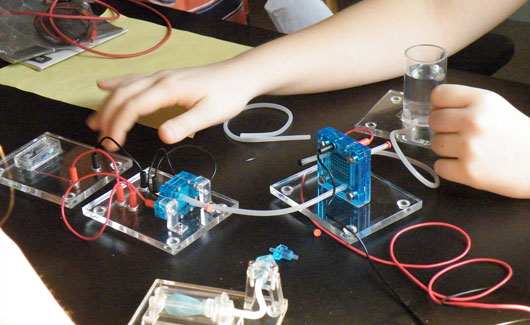|
|
|
|

Students participate in a workshop to create their own circuits. Image courtesy of kmakice on Flickr.
MIT’s Physics Department produces the most undergraduate and graduate physics students of any university in the United States. The undergraduate curriculum offers students the opportunity to acquire a deep conceptual understanding of fundamental physics. In addition, the course of study prepares students for graduate work in physics, as well as fields like astrophysics, biophysics, engineering and applied physics, geophysics, management, law, and medicine.
Learn more about the MIT Department of Physics.
We have selected relevant material from MIT's introductory courses to support students as they study and educators as they teach the AP* Physics curriculum. This section is organized by the topics that you’ll see on the Physics exam.
* AP is a registered trademark of the College Board, which was not involved in the production of, and does not endorse, this product.
The following courses have been selected to help you explore Physics at MIT. The first course listed below, Classical Mechanics (8.01SC), is in our OCW Scholar format. OCW Scholar courses are designed for study at your own pace. They contain substantially more material than typical OCW courses, blending new content with existing material used in MIT classes.
Learn more about OCW Scholar.
| » Classical Mechanics (8.01SC) | Prof. Deepto Chakrabarty, Dr. Peter Dourmashkin, Dr. Michelle Tomasik, Prof. Anna Frebel, Prof. Vladan Vuletic |
| » Introduction to Astronomy (8.282J) | Prof. Saul Rappaport |
| » Chandra Astrophysics Institute | Mark Hartman, Peter Ashton, Shakib Ahmed, Simba Kol, Dr. Irene Porro |
| » Hands-On Astronomy: Observing Stars and Planets (12.409) | James Elliot |
| » Introduction to Special Relativity (8.20) | Bruce Knuteson |
| » Relativity (8.033) | Prof. Max Tegmark |
| » Physics of Rock Climbing (ES.255) | David Custer |
Testing theories and hypotheses in a lab is an important part of the physics curriculum at MIT. The work done in lab provides hands-on learning and reinforcement of the concepts presented during class lectures.
We have provided some of the most interesting and popular physics experiments from OCW to help you get a taste of what a physicist might do in a lab setting.
| » From course Physics I: Classical Mechanics with an Experimental Focus (8.01X) | Prof. Kate Scholberg, Dr. Peter Dourmashkin |
| » From course Electricity and Magnetism (8.02T) | Bruce Knuteson, Prof. Eric Hudson, Dr. George Stephans, Prof. John Belcher, Prof. John Joannopoulos, Prof. Michael Feld, Dr. Peter Dourmashkin |
| » From course Physics II: Electricity Magnetism with an Experimental Focus (8.02X) | Prof. Gunther M. Roland, Dr. Peter Dourmashkin |
| » Weather in a Tank: A Laboratory Guide to Rotating Tank Fluid Experiments and Atmospheric Phenomena | Lodovica Illari |
| » From course Atmosphere, Ocean and Climate Dynamics (12.003) | Prof. Raffaele Ferrari |
WARNING NOTICE
The experiments described in these materials are potentially hazardous. Among other things, the experiments should include the following safety measures: a high level of safety training, special facilities and equipment, the use of proper personal protective equipment, and supervision by appropriate individuals. You bear the sole responsibility, liability, and risk for the implementation of such safety procedures and measures. MIT and Dow shall have no responsibility, liability, or risk for the content or implementation of any of the material presented. Legal Notice
These courses were offered through the High School Studies Program (HSSP), a project of the MIT Educational Studies Program. HSSP offers non-credit enrichment courses to 7th-12th grade students on weekends at MIT.
| » The Big Questions | Nicholas DiBella |
| » Excitatory Topics in Physics | Nicholas DiBella |